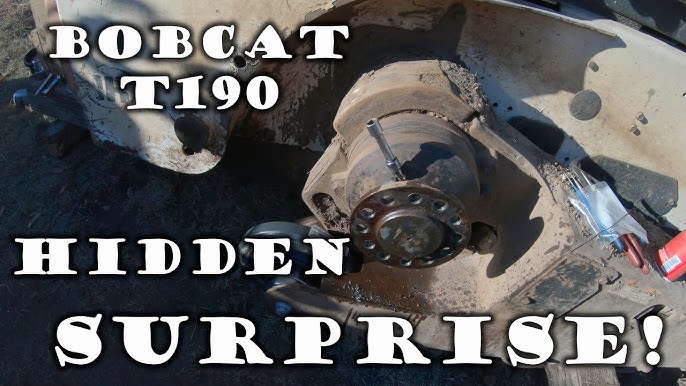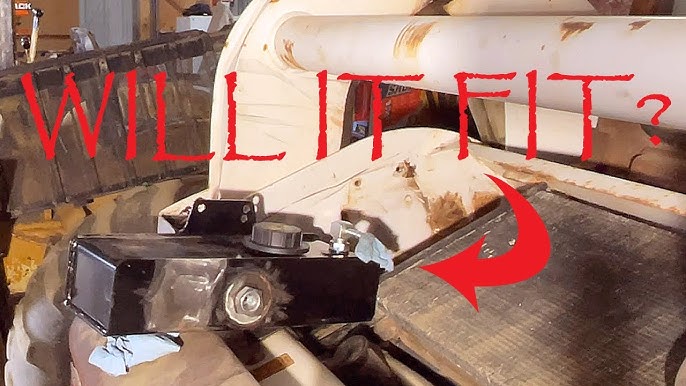If you own a Bobcat T190, you know how powerful and versatile it can be. But what happens when your machine starts acting up?
Dealing with Bobcat T190 problems can slow down your work and cause frustration. You want quick fixes and clear answers to get back on track fast. You’ll discover the most common issues with the Bobcat T190 and practical solutions you can use right away.
Keep reading to protect your investment and keep your machine running smoothly.

Credit: www.youtube.com
Frequent Engine Troubles
The Bobcat T190 is a reliable machine, but its engine can face some common issues. Frequent engine troubles affect performance and cause downtime. Understanding these problems helps in quicker fixes and better maintenance.
Starting Difficulties
Starting problems are common with the Bobcat T190 engine. The engine may crank but fail to start. Low battery power often causes this issue. Dirty or faulty spark plugs also block ignition. Fuel system problems can stop fuel flow. Regular checks keep the starting system healthy.
Overheating Causes
Engine overheating happens if cooling parts fail. A clogged radiator restricts airflow and coolant flow. Low coolant levels lead to higher engine temperatures. A broken water pump stops coolant circulation. Overheating can cause engine damage if ignored.
Unusual Engine Noises
Strange noises from the engine warn of trouble. Knocking sounds might mean worn bearings or poor fuel. Squealing noises often come from loose belts. Tapping sounds can show valve or lifter issues. Early noise detection helps avoid costly repairs.
Hydraulic System Challenges
The Bobcat T190 is a reliable machine, but its hydraulic system can face some common challenges. These issues affect how well the machine works. Understanding these problems helps in keeping the T190 running smoothly. The hydraulic system controls many important functions like lifting and moving attachments. Problems here can slow down work and cause delays.
Slow Hydraulic Response
Slow hydraulic response means the machine reacts late to controls. This delay happens when hydraulic fluid flows slowly or parts inside the system wear out. It makes operating the Bobcat frustrating and less efficient. Dirt or old fluid can also cause slow movement. Checking and changing the hydraulic fluid regularly helps avoid this problem.
Leaking Hydraulic Fluid
Leaking hydraulic fluid is a common issue in the T190. Leaks reduce the fluid level and pressure needed for smooth operation. Leaks often come from worn seals, hoses, or fittings. Small leaks might look harmless but can lead to bigger damage. Regular inspections and quick repairs stop leaks from causing costly problems.
Pressure Loss Problems
Pressure loss reduces the power of the hydraulic system. Without enough pressure, the Bobcat T190 cannot lift or move heavy loads properly. Pressure loss can come from faulty pumps or clogged filters. Air trapped in the system also lowers pressure. Fixing these issues keeps the machine strong and reliable during work.
Electrical Malfunctions
Electrical malfunctions are common issues with the Bobcat T190. These problems can stop the machine from working well. Understanding these electrical faults helps in fixing them faster. Regular checks help keep your Bobcat running smoothly. Below are key electrical problems to watch for.
Battery And Charging Issues
Battery problems cause starting troubles and power loss. A weak or dead battery means the Bobcat won’t start. Charging system faults stop the battery from getting full power. Check battery terminals for dirt and tightness. A faulty alternator can also cause charging failures. Replace worn batteries to avoid sudden breakdowns.
Faulty Wiring Symptoms
Damaged or loose wires cause strange machine behavior. Flickering lights or sudden stops hint at wiring issues. Corrosion or broken wires interrupt electrical flow. Inspect wiring harnesses regularly to find any damage. Repair or replace faulty wires to prevent bigger problems. Wiring faults can cause safety risks if ignored.
Control Panel Glitches
Control panel problems confuse the operator and affect performance. Malfunctioning buttons or displays make it hard to use controls. Loose connections behind the panel cause erratic readings. Software errors in the control unit also create glitches. Resetting or repairing the control panel often solves the issue. Always keep the panel clean and dry for best results.
Credit: www.skidsteerforum.com
Track And Undercarriage Wear
The track and undercarriage of the Bobcat T190 face constant wear during work. These parts support the machine’s weight and help it move on rough surfaces. Over time, wear can cause problems that reduce performance and increase repair costs. Understanding common issues helps owners keep their machines in good shape.
Track Slippage Signs
Track slippage means the tracks lose grip on the ground. The machine may slide or jerk during operation. Look for uneven movement or strange noises from the tracks. Track slippage can also cause faster wear on the undercarriage parts. Early detection prevents bigger damage.
Undercarriage Component Damage
Damage to undercarriage parts like rollers, sprockets, and idlers affects machine stability. Worn components cause rough rides and uneven track wear. Check for cracks, dents, or missing parts regularly. Damaged components need quick replacement to avoid further issues.
Proper Track Tensioning
Track tension must be just right—not too tight or loose. Too tight wears parts faster and strains the machine. Too loose causes track slippage and uneven wear. Use the manufacturer’s guidelines for correct tensioning. Regular checks keep the tracks working smoothly and lasting longer.
Cab And Operator Comfort Issues
The Bobcat T190 is known for its compact design and power. Still, operators often report issues inside the cab. Comfort and ease of control play a big role in daily work. Problems in this area can affect productivity and safety.
Many users mention discomfort during long hours. Small design flaws add up, making operation tiring. Let’s explore the main cab and comfort issues in detail.
Seat And Control Wear
Seat cushions on the T190 wear out faster than expected. Foam loses shape, causing discomfort. Controls also show signs of wear. Buttons and levers become loose or stiff. This reduces operator precision and comfort. Replacing parts often is a common need.
Visibility And Safety Concerns
Visibility inside the cab can be limited. Large blind spots make work tricky. Dirt and scratches on windows reduce clarity. Poor sight lines increase the risk of accidents. Operators must stay alert to avoid hazards. Some users add extra mirrors or cameras.
Climate Control Problems
The heating and air conditioning systems often underperform. Cooling is weak in hot weather. Heating takes longer to warm the cab. Fans can be noisy or fail over time. Uncomfortable temperatures affect focus and endurance. Regular maintenance helps but does not fully solve it.
Maintenance Tips For Longevity
Maintaining your Bobcat T190 is key to keeping it running well. Regular care helps avoid common problems. It also extends the machine’s life. Follow simple steps to keep the loader in top shape.
Routine Inspection Checklist
Start each day with a quick check. Look for leaks, cracks, or worn parts. Check tire pressure and tread condition. Ensure all lights and signals work. Test the brakes and steering for smoothness. Tighten any loose bolts or fittings. Clean dirt and debris from the machine. These small checks prevent big issues later.
Fluid Replacement Schedule
Change engine oil every 250 hours or as recommended. Replace hydraulic fluid every 1,000 hours or sooner if needed. Check coolant levels weekly and top off if low. Use only the fluids specified in the owner’s manual. Old fluids cause wear and reduce performance. Keeping fluids fresh protects the engine and hydraulics.
Preventive Measures
Store the Bobcat in a covered place to protect it from weather. Avoid overloading or pushing beyond its limits. Clean air filters every 100 hours to maintain airflow. Grease all fittings regularly to reduce friction. Use the machine on suitable surfaces to prevent damage. Regularly update software and check for recalls. These actions help avoid costly repairs.
Expert Repair Strategies
Expert repair strategies for Bobcat T190 problems help owners save time and money. These strategies guide you through common repairs. They also show when to seek professional help. Understanding cost-effective solutions keeps your Bobcat running well. This section breaks down practical tips for repairs.
Diy Fixes For Common Issues
Many Bobcat T190 problems have simple fixes. Start with checking fluid levels and filters. Clean or replace clogged air filters regularly. Tighten loose bolts and inspect hydraulic lines. Replace worn-out belts and hoses quickly. Use the owner’s manual for step-by-step guidance. Keep basic tools handy for small repairs. These fixes prevent major damage and downtime.
When To Consult A Professional
Some repairs need expert skills and tools. Electrical issues or engine problems may require a technician. Hydraulic system failures often need professional attention. If the machine shows unusual noises or leaks, seek help. Complex diagnostics avoid costly mistakes. Professionals ensure safe and correct repairs. Don’t delay calling an expert when unsure.
Cost-effective Repair Solutions
Save money with smart repair choices. Buy quality parts from trusted suppliers. Use refurbished or OEM components when possible. Regular maintenance reduces the chance of expensive repairs. Compare quotes from different repair shops. Ask about warranties on parts and labor. Proper care extends the life of your Bobcat T190. Choose repairs that offer long-term value.

Credit: www.youtube.com
Frequently Asked Questions
What Are Common Engine Issues With Bobcat T190?
Engine problems often include overheating, rough idling, and loss of power in Bobcat T190.
Why Does My Bobcat T190 Lose Hydraulic Pressure?
Hydraulic pressure loss usually comes from leaks, clogged filters, or worn pump components.
How To Fix Bobcat T190 Starting Problems?
Check battery charge, fuel supply, and ignition system to resolve starting issues quickly.
What Causes Excessive Vibration In Bobcat T190?
Vibration often results from loose parts, unbalanced components, or worn engine mounts.
How Often Should I Service Bobcat T190 Hydraulics?
Hydraulic systems need servicing every 250 hours or as recommended in the user manual.
Conclusion
The Bobcat T190 has some common problems to watch for. Knowing these issues helps you keep the machine working well. Regular checks and proper care can prevent many troubles. Small fixes now save big costs later. Stay alert to warning signs and act quickly.
This keeps your Bobcat running strong and safe. A well-maintained machine lasts longer and works better. Keep these tips in mind for smooth operation every day.
